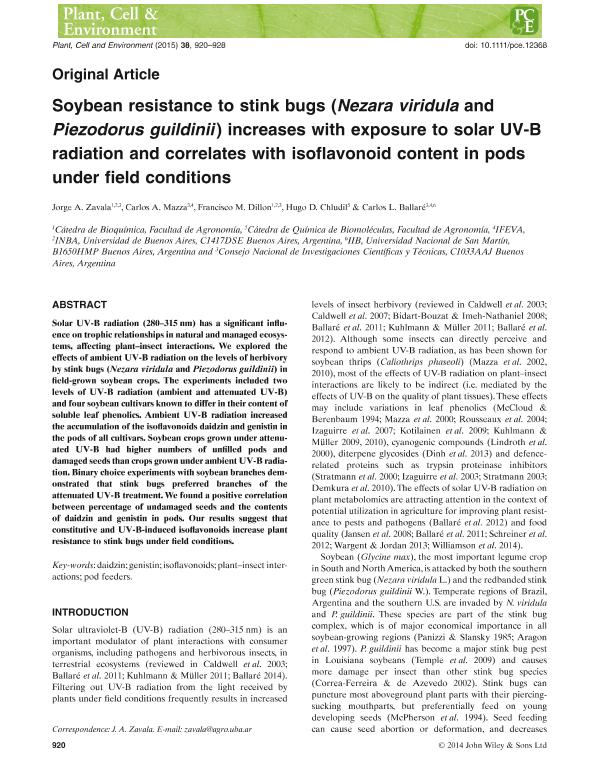Artículo
Soybean resistance to stink bugs (Nezara viridula and Piezodorus guildinii) increases with exposure to solar UV-B radiation and correlates with isoflavonoid content in pods under field conditions
Zavala, Jorge Alberto ; Mazza, Carlos Alberto
; Mazza, Carlos Alberto ; Dillon, Francisco María
; Dillon, Francisco María ; Chludil, Hugo Daniel; Ballare, Carlos Luis
; Chludil, Hugo Daniel; Ballare, Carlos Luis
 ; Mazza, Carlos Alberto
; Mazza, Carlos Alberto ; Dillon, Francisco María
; Dillon, Francisco María ; Chludil, Hugo Daniel; Ballare, Carlos Luis
; Chludil, Hugo Daniel; Ballare, Carlos Luis
Fecha de publicación:
05/2015
Editorial:
Wiley
Revista:
Plant, Cell And Environment
ISSN:
0140-7791
Idioma:
Inglés
Tipo de recurso:
Artículo publicado
Clasificación temática:
Resumen
Solar UV-B radiation (280–315 nm) has a significant influence on trophic relationships in natural and managed ecosystems, affecting plant–insect interactions. We explored the effects of ambient UV-B radiation on the levels of herbivory by stink bugs (Nezara viridula and Piezodorus guildinii) in field-grown soybean crops. The experiments included two levels of UV-B radiation (ambient and attenuated UV-B) and four soybean cultivars known to differ in their content of soluble leaf phenolics. Ambient UV-B radiation increased the accumulation of the isoflavonoids daidzin and genistin in the pods of all cultivars. Soybean crops grown under attenuated UV-B had higher numbers of unfilled pods and damaged seeds than crops grown under ambient UV-B radiation. Binary choice experiments with soybean branches demonstrated that stink bugs preferred branches of the attenuated UV-B treatment. We found a positive correlation between percentage of undamaged seeds and the contents of daidzin and genistin in pods. Our results suggest that constitutive and UV-B-induced isoflavonoids increase plant resistance to stink bugs under field conditions.
Palabras clave:
Flavonoid
,
Plant Defense
,
Insect
Archivos asociados
Licencia
Identificadores
Colecciones
Articulos(IFEVA)
Articulos de INST.D/INV.FISIOLOGICAS Y ECO.VINCULADAS A L/AGRIC
Articulos de INST.D/INV.FISIOLOGICAS Y ECO.VINCULADAS A L/AGRIC
Articulos(INBA)
Articulos de INST.DE INVEST. EN BIOCIENCIAS AGRICOLAS Y AMBIENTALES
Articulos de INST.DE INVEST. EN BIOCIENCIAS AGRICOLAS Y AMBIENTALES
Citación
Zavala, Jorge Alberto; Mazza, Carlos Alberto; Dillon, Francisco María; Chludil, Hugo Daniel; Ballare, Carlos Luis; Soybean resistance to stink bugs (Nezara viridula and Piezodorus guildinii) increases with exposure to solar UV-B radiation and correlates with isoflavonoid content in pods under field conditions; Wiley; Plant, Cell And Environment; 38; 5; 5-2015; 920-928
Compartir
Altmétricas



